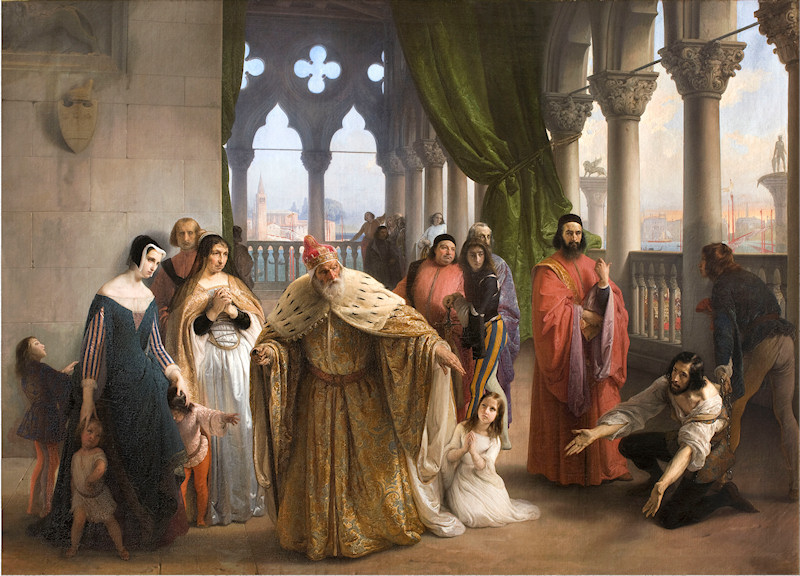Datei:Artgate Fondazione Cariplo - Hayez Francesco, L'ultimo abboccamento di Giacomo Foscari figlio del doge Giuseppe.jpg
Artgate_Fondazione_Cariplo_-_Hayez_Francesco,_L'ultimo_abboccamento_di_Giacomo_Foscari_figlio_del_doge_Giuseppe.jpg (800 × 576 Pixel, Dateigröße: 176 KB, MIME-Typ: image/jpeg)
![]()
Diese Datei und die Informationen unter dem roten Trennstrich werden aus dem zentralen Medienarchiv Wikimedia Commons eingebunden.
Beschreibung
| Francesco Hayez: Das letzte Zusammentreffen zwischen Jacopo Foscari und seiner Familie vor der Vertreibung ins Exil
|
||||||||||||||||||||||||||||
|---|---|---|---|---|---|---|---|---|---|---|---|---|---|---|---|---|---|---|---|---|---|---|---|---|---|---|---|---|
| Künstler |
artist QS:P170,Q223725 |
|||||||||||||||||||||||||||
| Titel |
Das letzte Zusammentreffen zwischen Jacopo Foscari und seiner Familie vor der Vertreibung ins Exil label QS:Lit,"L'ultimo abboccamento di Jacopo Foscari con la propria famiglia (I due Foscari)"
label QS:Len,"The Last Meeting between Jacopo Foscari and his Family Before Being Sent into Exile"
label QS:Lde,"Das letzte Zusammentreffen zwischen Jacopo Foscari und seiner Familie vor der Vertreibung ins Exil" |
|||||||||||||||||||||||||||
| Objektart |
Gemälde object_type QS:P31,Q3305213 |
|||||||||||||||||||||||||||
| Beschreibung |
The painting was commissioned in 1838 by Emperor Ferdinand I, who had arrived in Milan for his coronation as king of Lombardy and Veneto, and it was destined for the Belvedere Gallery in Vienna. On its completion in 1840 the work was valued at the extremely high price of five thousand florins by the Commissione Permanente di Pittura dell’Accademia di Brera, which thus recognized its exceptional quality. In 1928 this large canvas was auctioned at the Galleria Scopinich in Milan, together with other valuable Italian paintings from the imperial collections, where it was bought by Antonio Bernocchi an important member of the rising entrepreneurial middle class, who was active in the textile sector and became senator of the Kingdom of Italy in 1929. The painting entered the Cariplo Collection from this prestigious private collection in 1989. Histoire de la République de Venise by the French historian Pierre Daru is the literary source of this episode regarding the Doge, who was forced to accept that his son Jacopo was sentenced to exile after being unjustly accused of treason. This subject had also been formerly addressed by Lord Byron in 1821 in his tragedy The Two Foscaris, which inspired the opera of the same name in 1844 by Giuseppe Verdi. The critics immediately recognised the theatrical appeal of history painting that often chose the same subjects as the more popular operas. The general public readily identified with the events depicted on canvas because of the precise reconstruction of settings, costumes and gestures, but also because they included portraits of their contemporaries as historical figures. In this canvas in the Collection the Doge is an older self portrait of Hayez himself, and with a dramatic gesture he forces his son to respect the decision of the Council of Ten, as he leans on his stick trembling with emotion. The differing reactions of the figures around him are evident: the silent suffering of the women; the icy expression of Jacopo’s enemy Loredano standing beside him, as the condemned son stretches out his hands towards his father; the various emotions of the children. Jacopo’s leavetaking of his family is rendered even more agonising by the allusion to his imminent departure from his homeland evident in the view of the lagoon with the ships about to set sail, which can be glimpsed through the portico of the Ducal Palace. The myth of Venice and the loneliness of the powerful are condensed in this episode, which Hayez treated repeatedly in several versions, including the famous canvas commissioned by his friend and adviser Andrea Maffei and executed between 1852 and 1854 (Florence, Galleria d’Arte Moderna Palazzo Pitti). The artist’s dramatic sensibility and the similarity between his painting and Verdi’s opera, was further confirmed when he was asked to revise the costume-sketches for the staging of The Two Foscaris in 1858. |
|||||||||||||||||||||||||||
| Abgebildete Personen |
Jacopo Foscari |
|||||||||||||||||||||||||||
| Datum |
zwischen 1838 und 1840 date QS:P571,+1850-00-00T00:00:00Z/7,P1319,+1838-00-00T00:00:00Z/9,P1326,+1840-00-00T00:00:00Z/9 |
|||||||||||||||||||||||||||
| Technik |
Öl auf Leinwand medium QS:P186,Q296955;P186,Q12321255,P518,Q861259 |
|||||||||||||||||||||||||||
| Maße |
Höhe: 165 cm; Breite: 233 cm dimensions QS:P2048,165U174728 dimensions QS:P2049,233U174728 |
|||||||||||||||||||||||||||
| Sammlung |
institution QS:P195,Q2054135 |
|||||||||||||||||||||||||||
| Momentaner Standort |
Italiano: Sezione II |
|||||||||||||||||||||||||||
| Inventarnummer |
AH01833AFC |
|||||||||||||||||||||||||||
| Bemerkungen | Elena Lissoni, Artgate Fondazione Cariplo | |||||||||||||||||||||||||||
| Referenzen |
|
|||||||||||||||||||||||||||
| Herkunft/Fotograf | Artgate Fondazione Cariplo | |||||||||||||||||||||||||||
| Genehmigung (Weiternutzung dieser Datei) |
Diese Datei ist unter der Creative-Commons-Lizenz „Namensnennung – Weitergabe unter gleichen Bedingungen 3.0 nicht portiert“ lizenziert. Namensnennung: Fondazione Cariplo
|
|||||||||||||||||||||||||||
Lizenz
- Dieses Werk darf von dir
- verbreitet werden – vervielfältigt, verbreitet und öffentlich zugänglich gemacht werden
- neu zusammengestellt werden – abgewandelt und bearbeitet werden
- Zu den folgenden Bedingungen:
- Namensnennung – Du musst angemessene Urheber- und Rechteangaben machen, einen Link zur Lizenz beifügen und angeben, ob Änderungen vorgenommen wurden. Diese Angaben dürfen in jeder angemessenen Art und Weise gemacht werden, allerdings nicht so, dass der Eindruck entsteht, der Lizenzgeber unterstütze gerade dich oder deine Nutzung besonders.
- Weitergabe unter gleichen Bedingungen – Wenn du das Material wiedermischst, transformierst oder darauf aufbaust, musst du deine Beiträge unter der gleichen oder einer kompatiblen Lizenz wie das Original verbreiten.
Kurzbeschreibungen
In dieser Datei abgebildete Objekte
Motiv
image/jpeg
f3c89e8d7a2bbd7cc135187a9fd6233c3d4b601b
179.978 Byte
576 Pixel
800 Pixel
Dateiversionen
Klicke auf einen Zeitpunkt, um diese Version zu laden.
| Version vom | Vorschaubild | Maße | Benutzer | Kommentar | |
|---|---|---|---|---|---|
| aktuell | 12:36, 9. Sep. 2011 |  | 800 × 576 (176 KB) | M.casanova |
Dateiverwendung
Die folgende Seite verwendet diese Datei:
Globale Dateiverwendung
Die nachfolgenden anderen Wikis verwenden diese Datei:
- Verwendung auf ar.wikipedia.org
- Verwendung auf en.wikipedia.org
- Verwendung auf eo.wikipedia.org
- Verwendung auf fr.wikipedia.org
- Verwendung auf it.wikipedia.org
- Verwendung auf it.wikibooks.org
- Verwendung auf lt.wikipedia.org
- Verwendung auf nl.wikipedia.org
- Verwendung auf ru.wikipedia.org
- Verwendung auf sh.wikipedia.org
- Verwendung auf sr.wikipedia.org
- Verwendung auf sv.wikipedia.org
- Verwendung auf uz.wikipedia.org
- Verwendung auf www.wikidata.org



